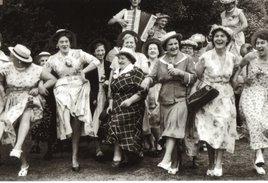Ach, Mutter,This old, black dress, I have been embroidering French flowers on it. [1]
When my mother was a little girl, my grandmother worked as a tailor at the Sears and Roebuck factory down by the Mississippi River, a job she held during the Great Depression and for many years after. She became an expert seamstress.
Mamaw’s hands, gnarled with purple and blue veins and hard pointed fingernails that she filed regularly, were not rough, but they weren’t soft either. Sometimes she painted her nails a soft pink color, but most of the time her hands were busy—hanging clothes on the line—a continuous supply of socks, shorts, and smocks worn by me and my four brothers and sisters, chopping onions, peeling hard-boiled eggs, making the beds with box corners, rubbing our croupy chests with Vicks Vapor-rub, and always—sewing. Her brown wicker sewing basket was always nearby.
She seemed to be constantly patching pants, replacing buttons, darning socks, or embroidering a new face on an old stuffed animal. Her stitches and her imagination could transform something plain into an item of beauty. She made Barbie doll clothes out of fabric scraps and matching night gowns for my rag doll and me. But the most amazing thing she did was to make her stitches disappear while she sewed.
I sat by her on the couch many times as she wet the tip of a long thread with her tongue, then deftly passed the end through the eye of a needle, pulling the two thread ends even with each other, then wrapping them swiftly around her finger and into a secure knot. Into the fabric the needle went, and out again, up and down, every stitch disappearing as she worked. "Over, Mamaw! Let me see the back!" But the backs were always void of stitches too, and Mamaw always laughed at my perplexion. Many times she tried to show me how to sew, but my stitches glared from the fabric like the cracks on the school playground. I felt special whenever I wore something she had made. Store bought clothing just didn’t have the same feel and I began to wonder if Mamaw was magic. But like all Southern women of her time, Mamaw followed the social rules of etiquette, even when sewing, the same rules that governed how a lady looked, acted and even felt:
1) Never wear white in the winter
2) Black is for funerals or adult formal wear, not for children
3) Always wear gloves to church, or carry a pair if you haven't had time to wash them
4) Never carry a purse that doesn’t match your shoes
5) Always carry a hanky—one with your initials embroidered on it if you’re lucky
6) Always wear clean underwear in case you get in a car accident and have to go to the hospital
7) Before you leave the house, make sure your slip isn’t ‘showing.’
One Easter, Mamaw bought matching dresses of yellow and white dotted swiss for me and my younger sister. I don’t know if she was too busy to sew, or the dresses were on sale, but I knew it was supposed to be a privilege to wear store bought. Our yellow dresses screamed "Springtime!” They were delicate and lacey but the feeling wasn’t there.
When we returned home after Sunday services, the rain had stopped but water was still flowing down the gutter. The air smelled sweet and felt balmy and clean. We were leaving soon for Easter dinner at Mamaw's house, and Mama warned my sister and me not to get dirty, but we just wanted to float boats down the street—curled leaves and some empty walnut shell halves, pretending that fairies were going for a ride down a wild river. Fifteen minutes later, my mother’s face crumpled into disappointment when she saw the mud splatters on our new dresses. She hurried to get a rag and soap, but the stains didn’t come out completely.
When Easter came the next year, I was surprised when my grandmother pulled a piece of black velvet from her sewing closet and began measuring me. By the end of the day, I was wearing a beautiful new jumper over a white blouse, but something wasn't right. I turned slowly for my grandmother while she looked the dress over with a crease in her forehead. She tugged on the hem, pulled the dress at the back to test wiggle room, smoothed the jewel neckline. “It fits, Mamaw, it feels perfect!” But she continued to frown. “Aha!” she said a moment later, and reached for her mysterious sewing basket. I watched my grandmother’s hands while she rummaged through various containers: a miniature Whitman’s chocolate box that still smelled like chocolate even though it was full of snaps; an empty mayonnaise jar filled with buttons of every shape and color; a cigar box fraying at the edges, the mysterious contents of which were always changing. Mamaw's sewing basket not only held needles and thread, but zippers, rolls of ribbon and lace, rosettes, hooks and eyes, iron-on patches, thimbles and various small tools—contents that kept me entertained when I was little, and continued to fascinate me later.
Suddenly as from thin air, she held up two pink rose appliqués, one in each hand. “Ohhh!” I had never seen anything so beautiful. I fingered their soft raised texture. Within minutes, Mamaw had sewn one to each shoulder of the dress, the stitches disappearing with each prick of the needle. I viewed myself in the mirror. The pink roses glowed like the first tulips of spring. I smiled at my grandmother's soft expression and she smiled back. Now I had proof positive. I was going to wear black velvet. In the Spring time. To church. On Easter Sunday. My grandmother was indeed, magic.
[1] Wallace Stevens (1879–1955), U.S. poet. “Explanation.”
July's Random Pics
10 years ago


No comments:
Post a Comment